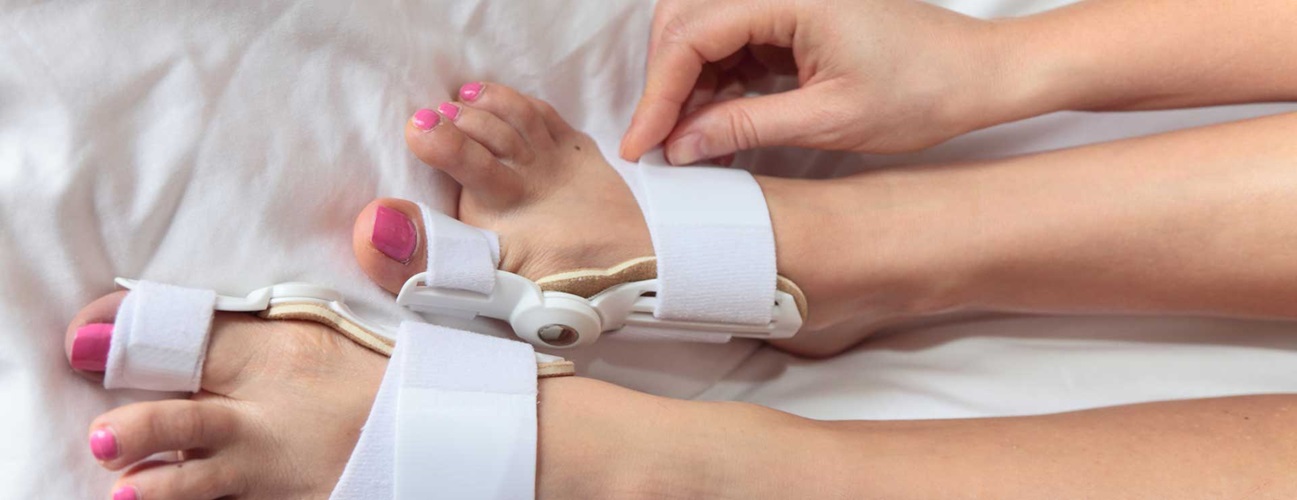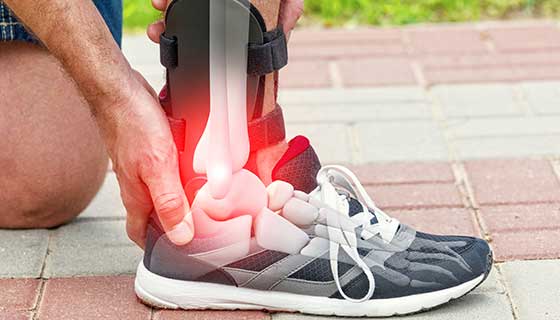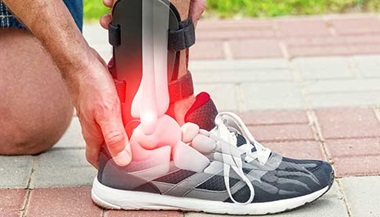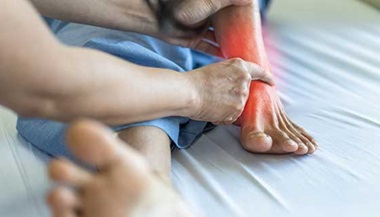Bunion Surgery
What is bunion surgery?
Bunion surgery is done to reduce the pain and correct the deformity caused by a bunion. A bunion (hallux valgus) is an enlargement of the bone or tissue around a joint at the base of the big toe or at the base of the little toe. This one is called a "bunionette" or "tailor's bunion." Bunions often form when the joint is stressed over a prolonged period. Most bunions form in women, primarily because women may be more likely to wear tight, pointed, and confining shoes. Bunions may be inherited as a family trait. Bunions may also result from arthritis. This often affects the big toe joint.
Before surgery is considered, your healthcare provider may recommend first wearing comfortable, well-fitting footwear (particularly shoes that conform to the shape of the foot and do not cause pressure areas). He or she may also suggest using splints and orthotics (special shoe inserts shaped to your feet) to reposition the big toe and/or provide padding. For bunions caused by arthritis, medicines may help reduce pain and swelling.
If these treatments don't help, your healthcare provider may suggest surgery. This often resolves the problem. The goal of surgery is to relieve pain and correct as much deformity as possible. The surgery is not cosmetic and is not meant to improve the appearance of the foot.
Other related procedures that may be used to help diagnose foot disorders include X-rays of the bone and foot. Please see these procedures for more information.
The type of surgical procedure performed depends on the severity of the bunion, your age, general health, activity level, and the condition of the bones and connective tissue. Other factors may influence the choice of a procedure used:
- Mild bunion. For this type of surgery, the surgeon may remove the enlarged portion of bone and realign the muscles, tendons, and ligaments surrounding the joint.
- Moderate bunion. For a moderate bunion, the surgeon may cut the bone and shift it to its proper position. Whether or not the bone is cut depends on the severity and location of the deformity. In addition, the surrounding tendons and ligaments may need to be repositioned.
- Severe bunion. For a severe bunion, surgery may involve removing the enlarged portion of the bone, cutting and realigning the bone, and correcting the position of the tendons and ligaments.
- Arthritic bunion or big toe joint. If the joint is damaged beyond repair, as is often seen in arthritis, it may need to be fused. This allows the bones to heal together and eliminate movement and pain. Occasionally, joint replacement implants may be used in the reconstruction of the big toe joint.
Why might I need bunion surgery?
You may need bunion surgery if you have severe foot pain that happens even when walking or wearing flat, comfortable shoes. Surgery may also be needed when chronic big toe inflammation and swelling isn't relieved with rest or medicines.
Other reasons for surgery include toe deformity, a drifting in of the big toe toward the small toe, and an inability to bend and straighten the big toe.
There may be other reasons for your healthcare provider to recommend bunion surgery.
What are the risks of bunion surgery?
As with any surgical procedure, complications can happen. Some possible complications may include:
-
Stiffness
-
Numbness
-
Swelling
-
Delayed healing
-
Infection
Other complications may include recurrence of the bunion, nerve damage, and continued pain. The surgery may also result in overcorrection of the problem, in which the big toe extends away from the other toes.
There may be other risks depending on your specific medical condition. Be sure to discuss any concerns with your healthcare provider before the procedure.
How do I prepare for bunion surgery?
-
Your healthcare provider will explain the procedure to you and offer you the chance to ask any questions that you might have about the procedure.
-
You will be asked to sign a consent form that gives your permission to do the procedure. Read the form carefully and ask questions if something is not clear.
-
In addition to a complete medical history, your healthcare provider may perform a complete physical exam to make sure that you are in good health before undergoing the procedure. You may undergo blood tests or other diagnostic tests.
-
Tell your healthcare provider if you are sensitive to or are allergic to any medicines, latex, tape, and anesthetic agents (local and general).
-
Tell your healthcare provider of all medicines (prescribed and over-the-counter) and herbal supplements that you are taking.
-
Tell your healthcare provider if you have a history of bleeding disorders or if you are taking any anticoagulant (blood-thinning) medicines, aspirin, or other medicines that affect blood clotting. It may be necessary for you to stop these medicines before the procedure.
-
If you are pregnant or suspect that you are pregnant, you should notify your healthcare provider.
-
You may be asked to fast for 8 hours before the procedure, generally after midnight.
-
You may receive a sedative before the procedure to help you relax. Because the sedative may make you drowsy, you will need to arrange for someone to drive you home.
-
Based on your medical condition, your healthcare provider may request other specific preparation.
What happens during bunion surgery?
Bunion surgery may be done on an outpatient basis or rarely as part of your stay in a hospital. Procedures may vary depending on your condition and your healthcare provider’s practices.
Most bunion surgery is performed under ankle block anesthesia, in which your foot is numb, but you are awake. Occasionally, general or spinal anesthesia is used.
Generally, bunion surgery follows this process:
-
You will be asked to remove clothing and will be given a gown to wear.
-
An intravenous (IV) line may be started in your arm or hand.
-
The skin over the bunion will be cleansed with an antiseptic solution.
-
If a local anesthetic is used, you will feel a needle stick when the anesthetic is injected. This may cause a brief stinging sensation. If general anesthesia is used, you will be put to sleep using intravenous medicine.
-
The healthcare provider will cut, realign, and possibly remove portions of bone, ligaments, and tendons of the affected foot based upon the severity of the bunion.
-
The healthcare provider will close the opening with stitches and apply a sterile bandage or dressing.
What happens after bunion surgery?
After your surgery, you will be taken to the recovery room for observation. Your recovery process will vary depending on the type of anesthesia that is given. The circulation and sensation of the foot will be monitored. Once your blood pressure, pulse, and breathing are stable and you are alert, you will be taken to your hospital room or discharged to your home.
Your healthcare provider will give you specific instructions for caring for your foot at home during the first few weeks after surgery. You may be discharged from the hospital wearing a special surgical shoe or cast to protect your foot.
Once you are at home, you will need to rest and keep the foot elevated on 1 or 2 pillows to help reduce pain and swelling. Your healthcare provider may also recommend that you apply ice and limit walking. You may be advised to use a cane or walker following surgery.
It is important to keep the dressing clean and dry. You should cover the dressing with a plastic bag or plastic wrap and tape it with plastic tape when showering. An alternative is to take a sponge bath. The stitches will be removed during a follow-up visit, generally scheduled about two weeks after surgery.
Take a pain reliever for soreness as recommended by your healthcare provider. Aspirin or certain other pain medicines may increase the chance of bleeding. Be sure to take only recommended medicines. Your healthcare provider may also prescribe antibiotics to help prevent infection following your surgery.
Notify your healthcare provider to report any of the following:
-
Fever of 100.4°F (38°C) or higher, or as directed by your healthcare provider
-
Redness, swelling, bleeding, or other drainage from the incision site
-
Increased pain around the incision site
-
Swelling in lower leg of the affected foot
Your healthcare provider will advise you as to your postoperative activities. Your foot may need continuous support from dressings or a brace for 6 to 8 weeks after surgery. You may need to refrain from driving for a week or more after surgery.
Exercises or physical therapy may be recommended to help the foot recover its strength and range of motion after surgery. High heels should be avoided for at least 6 months after surgery.
Your healthcare provider may give you additional or alternate instructions after the procedure, depending on your particular situation.






